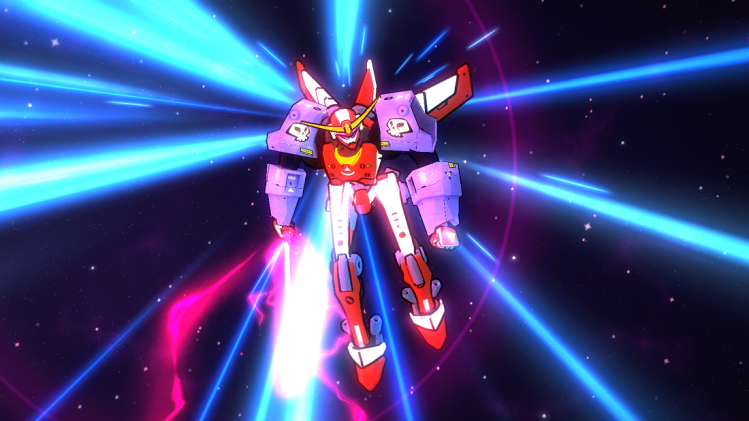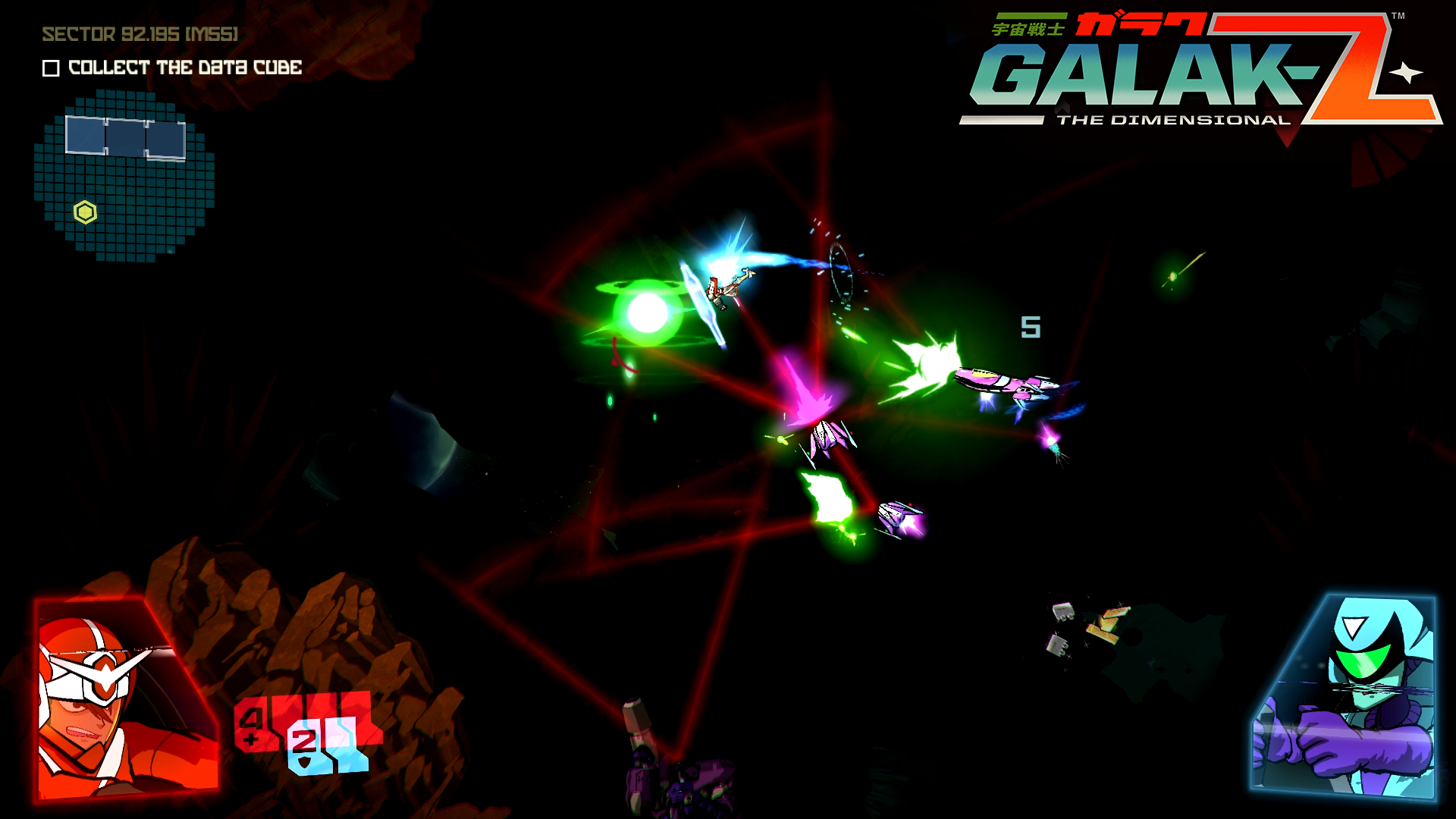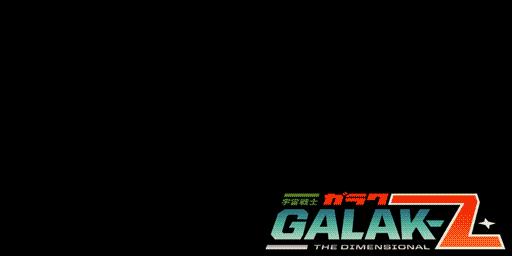Jake Kazdal smiled as he revealed the secret that he and his 17-Bit team kept for three Entertainment Electronic Expos.
Galak-Z: The Dimensional isn’t a space shooter. It’s a roguelike, and your ship transforms into a mech, with zero-G physics that capture what it’s like for objects to drift in space. It’s certainly innovative, as no other roguelike can claim such a pedigree. But Galak-Z showcases another juicy nugget — the love for the cheesy sci-fi that came from localized anime like Star Blazers and Robotech, and perhaps the cheesiest show from the late 1970s: Battlestar Galactica.
It all started in Seattle.
Cereal and sci-fi
Kazdal’s first encounter with a Japanese anime series is the same as most of his contemporaries’: Star Blazers, the U.S.-localization of the groundbreaking Space Battleship Yamato (a series that introduced depth and complexity to animation). Before heading off to elementary school, he would wake up extra-early — 6 a.m. — to catch it. This fostered a love for sci-fi within Kazdal.
“I grew up watching this stuff … my game has Star Wars, Battlestar Galactica, a little of Star Blazers. It was the only anime I knew of for years. I loved it,” Kazdal said. “To compete with big budget, you’ve got to stand out. I realize I am older than the typical age of a gamer. My tastes are still [relevant] — they grew up watching the same stuff I did. I did some research, and man, was that stuff cheesy. It’s fantastic.
“Galak-Z is a love letter to that era.”
The logo (from graphic designer Cory Schmitz) hews so closely to the motif that it even turns heads back in anime’s homeland. “It’s a bad-ass logo. Japanese people see the logo and think it’s an old show that they didn’t know about. It reeks of that era.”
How it happened
17-Bit does have a partnership with GungHo, the mobile gaming company from Japan famous for Puzzles & Dragons. And they’re working on a game together, but it’s a project that comes after Galak-Z. The funding for Kazdal’s project didn’t come from GungHo but two other sources: angel investors (these aren’t formal Silicon Valley venture capitalists, mind you) and Sony’s indie program.
“Sony’s been the main source of funding. We’re self-publishing,” Kazdal said. “Sony has been a fantastic partner. It shows how well they support indies.”
Galak-Z uses the Unity engine, which suits 17-Bit’s intention to bring their game to both PlayStation 4 and PC. These tools have a reputation for making it easy to port code from one platform to another, but Kazdal said his team learned that wasn’t the case when moving from PS4 to PC.
“Unity and PS4 have growing pains. Framerate issues, mistakes to clean up — it’s been a challenge,” he said. “Being an early adopter, we’re finding that Unity on the PS4 not as easy as PC.”
Development on Galak-Z started three years ago, back before the recent revolution that made more powerful engines like Unreal more affordable for indie devs.
“In Unity, you’re never going to compete with Killzone with graphics. There’s just too much gulf in between,” Kazdal said. “Rather have a bigger game with a smaller team [than that level of graphics].”
A mech war
In Galak-Z, your fighter is attached to the USS Axelios. Your warship and fighter are the lone survivors of a sneak attack by the Imperials during the signing of a peace treaty (another nod to BSG). Kazdal showed the second episode earlier this week at the GamesBeat office. After you defeat the first boss, you pick up a strange power-up. The second chapter kicks off with you facing the enemy.
Bad guys appear and approach. You pull a lever — it’s an experimental ship, after all — and it transforms into a … mech warrior. The skulls emblazoned on your ship (a call out to Kazdal’s most recent game, Skulls of the Shogun) are now on the shoulder pauldrons, and it has an energy sword.
The mech reminds me of Gundum, but as Kazdal said, “It could be from any anime series. They showed a lot of that overt samurai-inspired style.”
Galak-Z has an even stronger tie to Skulls of the Shogun than its visuals. In this chapter, you’re searching for the captive Admiral Akamoto, one of your space navy’s greatest tacticians (think Commander Cain from the original BSG). This Akamoto is a descendent of General Akamoto, the player character from Skulls.
Going rogue
The only roguelike I know with a mech theme is the browser game RogueMek, a take on the genre’s classic formula. Galak-Z mixes a space shooter with elements such as procedurally generated dungeons and a different take on perma-death. Instead of going all of the way back to the beginning when you croak, you go back to the start of the chapter in which you died.
When you die, you do hold on to some of your progress, specifically Chase Coins (named after Chase, who wants this rare currency that you collect). You hold on to some of these whenever you perish, so you can start your next attempt with a way to get some power-ups before heading into a dungeon. You also collect blueprints, which carry over from one playthrough to another, like with Rogue Legacy.
“This give you a bit of persistent growth,” Kazdal said.
Some power-ups stack. You can adjust loadouts, weapon systems, muzzles, bullets, and firing pattern. As your ship flies through space, its momentum carries it around (think of how fighters behave in Babylon 5).
Innovation also comes here in the form of a tractor beam: As you zip around, you can grab floating rocks, space junk, or even your enemies and use them as shield or throw them at foes. As a mech, your sword’s charge can sub in for a short-range attack. You also have a shield that can protect you for a few attacks.
Kazdal refuses to accept that roguelike development has a wall.
“I don’t buy that there’s no room for innovation with roguelikes, that everyone has done everything that can be done with them,” he said. “17-Bit stands for: ‘Classic genres with modern standards.'”
He also calls Galak-Z a “Far Cry experience in 2D” thanks to the physics, how the three factions (alien lifeforms, Imperials, and Void Raiders, which are space pirates) play off each other. You can pit one against the other, even luring a foe into an area where a giant interstellar bug will attack it. Holding still and hiding behind things helps facilitate this, though you can always use your tractor beam to toss an Imperial near a Void Raider to start a tussle.
“And it’s all in zero-G. It’s a big, organic playspace. It’s something new here,” Kazdal said. “We think this is really special. You haven’t seen everything yet.”
VentureBeat's mission is to be a digital town square for technical decision-makers to gain knowledge about transformative enterprise technology and transact. Learn More












